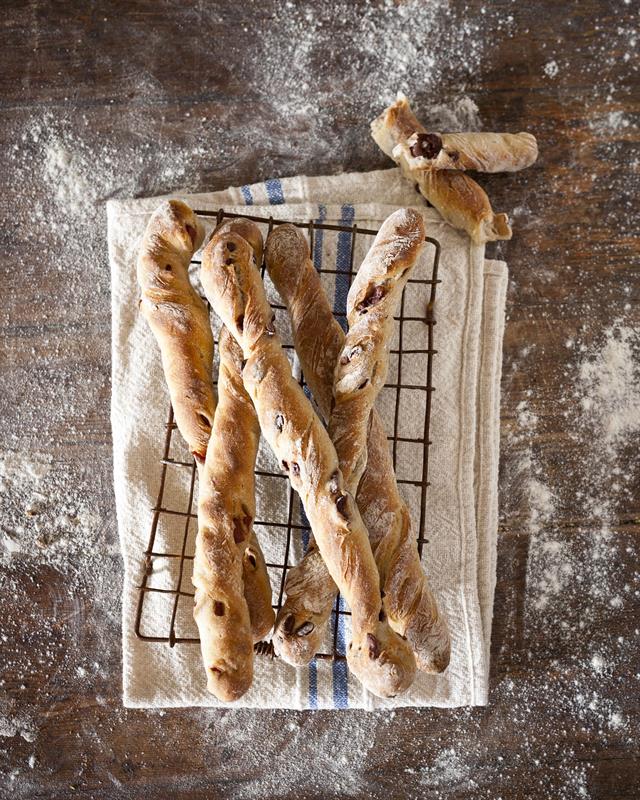Olive breadsticks make a great little snack, starter or side, and you can use whatever filling you like. These tasty sticks can be customised to suit any palate, so feel free to add in cheese, ham, or anything. There’s also no tricky shaping involved here – you almost can’t fail!
Olive breadsticks
Ingredients
Preferment
- 400g bread/all-purpose flour)
- 400ml water
- 1,25ml (¼ tsp)/small pinch yeast
Final Dough
- 400g bread/all-purpose flour + extra, to dust
- 200ml water
- 10ml (2 tsp) salt
- 5ml (1 tsp) yeast
- 400g preferment
- 250g olives, roughly chopped
Instructions
About 12 – 16 hours before you start (eg the night before a morning bake, or the morning of an evening bake), make up the preferment. Place the 440g flour, 400ml water and a,25 (¼ tsp) yeast in a mixing bowl and mix with a wooden spoon or by hand until everything is incorporated and no dry flour remains.
Clean the sides of the bowl and cover with cling film. Set aside at a cool room temperature (18°C) to stand, 12 – 16 hours. It is very difficult to accurately measure such a tiny amount of yeast – the time it takes before the preferment is ready could vary according to how accurately the yeast was measured. If possible, you should check the progress regularly and start the next step when the preferment dictates. It is ready to use when it has risen considerably, looks bubbly and smells ripe. There should be little wrinkles starting to appear on the surface, but it should not yet have collapsed. If you use it a bit early or late, not to worry – you will probably end up with pretty decent bread.
For the dough, place the 400g flour, 200ml water, salt, 5ml (1 tsp) yeast and half(400g) of your ripened preferment in a mixing bowl and hand mix until the dough starts to come together and is pulling away from the sides of the bowl.
Place the dough on a lightly dusted work surface and knead by gently stretching and folding the dough until it starts to look smooth and is not sticking to your hands much anymore, 5 – 10 minutes.
Lightly oil a large mixing bowl and place the dough in it. The dough will expand so make sure the bowl can accommodate this. Cover the bowl with cling film and set aside to ferment, 45 minutes.
Grab one edge of the dough and carefully stretch it up and over the centre of the dough. Start with the edge furthest from you, then repeat the action from the closest, left and, finally, right sides. You should feel and see the dough’s structure getting stronger as you do this. Finish by flipping the dough upside down. Return to the bowl, cover and leave for another 45 minutes.
Place the dough on a lightly dusted work surface and gently stretch into a rectangular shape that is almost 3 times as wide as it is long. Put a bit more than half of the olives on the right two thirds of the dough piece. Fold the empty left third over half of the olives and then fold this folded portion over the remaining olive-covered part. Rotate the dough a quarter turn and stretch this into a rectangle similar to the first one. (It will be smaller since the dough will have tightened up somewhat.) Repeat step 9 with the remaining olives. Let your dough rest, covered with a slightly damp tea towel, 15 – 20 minutes.
Cut the dough block into 10 roughly equal strips with a large knife and stretch and twist them so they are about 20cm – 25cm long. Place the sticks on a lined baking tray, cover with a tea towel and let them prove until soft and puffy, 1 – 1½ hours. Preheat the oven to 230°C.
When your sticks look ready, place the tray in the oven and bake, 20 – 25 minutes, depending on how crunchy you want your bread sticks to be. Remove from oven and allow to cool.
Notes
Cook’s tips: You can use pretty much any ingredient you like in place of the olives. We use chorizo, feta and olives, sun-dried tomatoes, and dark chocolate. The preferment can be hard to control. You might consider making a test one to see how long it takes to ripen in your particular environment with the amount of yeast you think is right. You are aiming to have your final dough at around 24°C after mixing. If your kitchen is colder than this, make the water warmer to compensate. If it’s hot in your kitchen, use cool water or even chilled. Try to have your dough rising at around 24°C too. Put it in a warm place if your kitchen is cooler than this, or extend the fermentation and rising time. You can make 20 sticks if you double up the final dough ingredients and use all of the preferment instead of half. At step 8, just divide the dough in 2 and make two batches. You can use different fillings in each. This dough is very versatile and can be shaped into any loaf you like.

